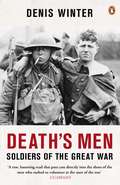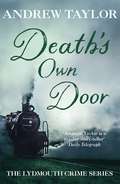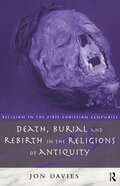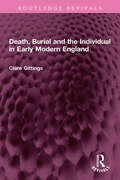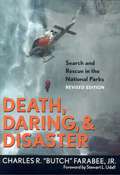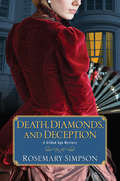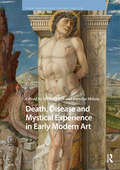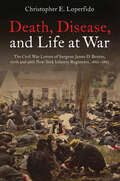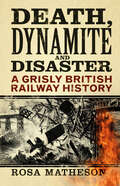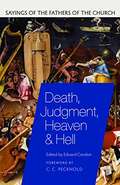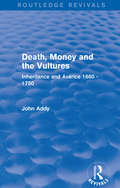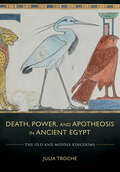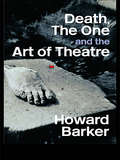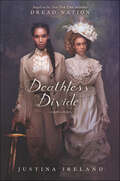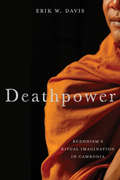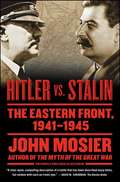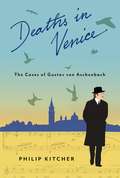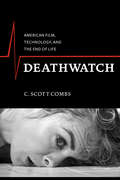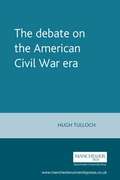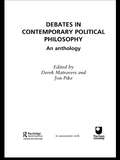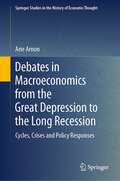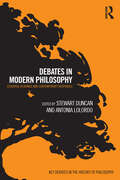- Table View
- List View
Death's Men: Soldiers Of The Great War
by Denis WinterDeath's Men is the classic bestselling story of the First World War as told by the soldiers themselves - reissued for the 2014 Centenary.Millions of British men were involved in the Great War of 1914-1918. But, both during and after the war, the individual voices of the soldiers were lost in the collective picture. Men drew arrows on maps and talked of battles and campaigns, but what it felt like to be in the front line or in a base hospital they did not know. Civilians did not ask and soldiers did not write.Death's Men portrays the humble men who were called on to face the appalling fears and discomforts of the fighting zone. It shows the reality of the First World War through the voices of the men who fought.'A raw, haunting read that puts you directly into the shoes of the men who rushed to volunteer at the start of the war' Guardian'An engrossing view of what it was like to live in the trenches, go on leave, get wounded, et cetera, and features voice after voice from the ranks' TelegraphDenis Winter was born in 1940 and read history at Pembroke College, Cambridge. Death's Men was first published in 1978, to critical and popular acclaim. This was followed by his book The First of the Few: Fighter Pilots of the First World War.
Death's Own Door: The Lydmouth Crime Series Book 6
by Andrew Taylor'Andrew Taylor is a master story-teller' Daily Telegraph From the No.1 bestselling author of The Ashes of London and The Fire Court, this is the sixth instalment in the acclaimed Lydmouth seriesWhen the body of Rufus Moorcroft, a middle-aged widower with a distinguished war record, is found in his summerhouse, the verdict is suicide. But both reporter Jill Francis and her lover, Detective Richard Thornhill, approaching the case from different angles, discover there's more to it than that. The key to the mystery stretches back to a highly-charged summer before the war, and back to another death. A local asylum plays a part, as do a moderately famous artist and his wife; Superintendent Williamson, now retired and loathing it; Councillor Bernie Broadbent - a man with more pies than fingers to put in them; a Cambridge don; an aristocratic unmarried mother, now gleefully drawing her old-age pension; and - to Thornhill's surprise and growing horror - his own wife, Edith.'An excellent writer. He plots with care and intelligence and the solution to the mystery is satisfyingly chilling' The Times'The most under-rated crime writer in Britain today' Val McDermid 'There is no denying Taylor's talent, his prose exudes a quality uncommon among his contemporaries' Time Out
Death's Own Door: The Lydmouth Crime Series Book 6
by Andrew Taylor'Andrew Taylor is a master story-teller' Daily Telegraph From the No.1 bestselling author of The Ashes of London and The Fire Court, this is the sixth instalment in the acclaimed Lydmouth seriesWhen the body of Rufus Moorcroft, a middle-aged widower with a distinguished war record, is found in his summerhouse, the verdict is suicide. But both reporter Jill Francis and her lover, Detective Richard Thornhill, approaching the case from different angles, discover there's more to it than that. The key to the mystery stretches back to a highly-charged summer before the war, and back to another death. A local asylum plays a part, as do a moderately famous artist and his wife; Superintendent Williamson, now retired and loathing it; Councillor Bernie Broadbent - a man with more pies than fingers to put in them; a Cambridge don; an aristocratic unmarried mother, now gleefully drawing her old-age pension; and - to Thornhill's surprise and growing horror - his own wife, Edith.'An excellent writer. He plots with care and intelligence and the solution to the mystery is satisfyingly chilling' The Times'The most under-rated crime writer in Britain today' Val McDermid 'There is no denying Taylor's talent, his prose exudes a quality uncommon among his contemporaries' Time Out
Death, Burial and Rebirth in the Religions of Antiquity (Religion in the First Christian Centuries)
by Jon DaviesIn Death, Burial and Rebirth in the Religions of Antiquity, Jon Davies charts the significance of death to the emerging religious cults in the pre-Christian and early Christian world. He analyses the varied burial rituals and examines the different notions of the afterlife. Among the areas covered are:* Osiris and Isis: the life theology of Ancient Egypt* burying the Jewish dead* Roman religion and Roman funerals* Early Christian burial* the nature of martyrdom.Jon Davies also draws on the sociological theory of Max Weber to present a comprehensive introduction to and overview of death, burial and the afterlife in the first Christian centuries which offers insights into the relationship between social change and attitudes to death and dying.
Death, Burial and the Individual in Early Modern England (Routledge Revivals)
by Clare GittingsFirst published in 1984, Death, Burial and the Individual in Early Modern England traces how and why the modern reaction to death has come about by examining English attitudes to death since the Middle Ages. In earlier centuries death was very much in the midst of life since it was not, as now, associated mainly with old age. War, plague and infant mortality gave it a very different aspect to its present one. The author shows in detail how modern concern with the individual has gradually alienated death from our society; the greater the emphasis on personal uniqueness, the more intense the anguish when an individual dies. Changes in attitudes to death are traced through alterations in funeral rituals, covering all sections of society from paupers to princes. This gracefully written book is a unique, scholarly and thorough treatment of the subject, providing both a sensitive insight into the feelings of people in early modern England and an explanation of the modern anxiety about death. The range and assurance of this book will commend it to historians and the interested general reader alike.
Death, Daring, and Disaster: Search and Rescue in the National Parks
by Charles R. Farabee Jr.375 exciting tales of heroism and tragedy drawn from the nearly 150,000 search and rescue missions carried out by the National Park Service since 1872.
Death, Diamonds, and Deception (A Gilded Age Mystery #5)
by Rosemary SimpsonThe pursuit of stolen diamonds once belonging to Marie Antionette leads heiress Prudence MacKenzie and ex-Pinkerton Geoffrey Hunter down a twisted maze through Gilded Age New York City from Fifth Avenue to Five Points . . . DEATH, DIAMONDS, AND DECEPTION Fall 1889: Lady Rotherton has arrived from London intent on chaperoning her niece Prudence through a New York social season to find a suitable husband. It's certainly not her niece's devilishly handsome partner in Hunter and MacKenzie Investigative Law. Aunt Gillian's eye for eligible suitors is surpassed only by her ability to discern genuine gems from nearly flawless fakes. At the Assembly Ball at Delmonico's, she effortlessly determines that the stones in the spectacular diamond waterfall necklace adorning the neck of the wife of banker William De Vries are fake. Insisting on absolute discretion to avoid scandal, the banker employs Prudence and Geoffrey to recover the stolen diamonds pried out of their settings—priceless stones acquired by Tiffany, originally purchased for Marie Antoinette. Their search for a possible fence rapidly leads to a dead end: a jeweler brutally killed in his shop during an apparent theft. The jeweler's murder is only the first in a string of mysterious deaths, as Prudence and Geoffrey pursue their elusive quarry. But the clues keep leading back to duplicity on the part of the De Vries family, who, it turns out, have a great deal to hide . . .
Death, Disease and Mystical Experience in Early Modern Art (Visual and Material Culture, 1300-1700)
by Michael Hill Jennifer MilamFear of death and disease preoccupied the European consciousness throughout the early modern era, becoming most acute at times of plague and epidemics. In these times of heightened anxieties, images of saints and protectors served to reassure the faithful of their religious protection against infection. Modes of visual engagement and devotional subject matter were coupled in new ways to reinforce the emotive impact of art works and to reaffirm the perceived reality of the afterlife. In this context, a visual language of mystical devotion, which overcame the limits of the body and even eroticised its suffering, could serve the needs of the desolate and the pained. In this series of essays focused on spiritual sensibilities in Renaissance art and its legacies, authors present original ideas about the themes of death, disease, and mystical experience, based primarily on the study of objects and their documented historical contexts. Methodologically wide-ranging in approach, the resulting volume provides novel insights into the interplay between suffering and art making in the Western world.
Death, Disease, and Life at War: The Civil War Letters of Surgeon James D. Benton, 111th and 98th New York Infantry Regiments, 1862–1865
by Christopher LoperfidoA collection of letters from a Union surgeon in the American Civil War, revealing what life was like for a doctor and a soldier in that era.Union surgeon James Dana Benton witnessed firsthand the suffering and death brought about by the ghastly wounds, infections, and diseases that wreaked havoc to both the Union and Confederate armies. A native of New York, Dr. Benton penned a series of letters throughout the war to his family relating his experiences with the 111th New York Infantry as an assistant surgeon, and later with the 98th New York as surgeon. This unique correspondence—which covers a wide array of topics beyond medicine and the treatment of the injured—is the basis of Death, Disease, and Life at War: The Civil War Letters of Surgeon James D. Benton, 111th and 98th New York Infantry Regiments, 1862-1865.Dr. Benton was present for some of the war’s most gruesome and important battles, including Gettysburg, Cold Harbor, and the siege of Petersburg. He was also present for the fall of Harpers Ferry, Abraham Lincoln’s second Inaugural address, and the collapse of Richmond. His pen offers an insightful and honest look into the everyday life of not only a Union surgeon, but also an officer who suffered the same basic hardships other soldiers in the ranks endured. Chris Loperfido’s Death, Disease, and Life at War is a valuable addition to the Civil War bookshelf.“More than 600,00 men perished in the Civil War, and many more were wounded or fell ill. Prompt and timely attention from an army surgeon was often the difference between life and death. James Benton’s letters home provide a compelling glimpse into the everyday life of these doctors—their concerns and frustrations, their patients and colleagues, the places visited, and their opinions on the war. I commend Christopher Loperfido for bringing this interesting slice of the war to light.” —Scott L. Mingus, Sr., award-winning author of Confederate General William “Extra Billy Smith”: From Virginia’s Statehouse to Gettysburg Scapegoat“Loperfido’s excellent arrangement of [Benton’s] letters provide[s] a compelling look at the life of a Union doctor during a time when the practice of medicine was still primitive and an understanding of health in general was scanty at best. Death, Disease, and Life at War is another valuable piece to the puzzle of understanding what it was like to serve in the Civil War.” —Meg Groeling, author of The Aftermath of the Battle: The Burial of the Civil War Dead
Death, Dynamite and Disaster: A Grisly British Railway History
by Rosa MathesonA safe mode of transport today, the railways were far from vehicles of sleepy commute when they first came into service; indeed, accidents were commonplace and sometimes were a result of something far more sinister. In this fresh approach to railway history, Rosa Matheson explores the grim and grisly railway past.These horrible happenings include memorable disasters and accidents, the lack of burial grounds for London’s dead, leading to the ‘Necropolis Railway’, the gruesome necessity of digging up the dead to accommodate the railways and how the discovery of dynamite gave rise to the ‘Dynamite Wars’ on the London Underground in the 1880s and 1890s. Join Rosa as she treads carefully through the fascinating gruesome history of Britain’s railways.
Death, Judgement, Heaven, and Hell: Sayings of the Fathers of the Church (Sayings of the Fathers of the Church Series #Volume 2)
by Edward CondonCatholic University of America Press is proud to present the second volume in its new Sayings of the Fathers of the Church Series. Featuring a wide range of scholars compiling material from our acclaimed Fathers of the Church volumes, each title will be devoted to a few specific areas of theology. The inaugural volume covered The Seven Deadly Sins, and future volumes are planned to focus on Angels and Demons, the Mass, and Mary. Nothing has the power to inspire, or terrify us like the unknown. Life after death is the perhaps the greatest unknown that confronts mankind. But the wisdom of the Church, especially in the teachings of the Church Fathers, reminds us that we know a great deal about what awaits us at the end of life. What the Church knows about the four last things?death judgment, heaven, and hell?is essential for helping on the way of the pilgrimage of life. The teachings of the Fathers, far from sating our curiosity, serve to increase the power of heaven to inspire us, and of hell to terrify. In this volume, canon lawyer and writer Edward Condon compiles a book full of wisdom and compelling insights. More than anything, the Fathers warn us that our life is short, and the reckoning for how we have lived it eternal. The urgency of the Church's message, brought to life in the sayings of the Fathers, comes to remind us of our true calling and inheritance in baptism, and of the richness of the heavenly reward, which is not so much the fruit of our efforts on Earth but the fulfillment of God's promise of love to us. The terror of hell is not the threat of the dictator, but a dire warning of the true scope of our freedom as children of God. This book, rich with the traditional teachings of the church, will guide and inspire readers as they continue their life journeys, which have a beginning but no end.
Death, Money and the Vultures: Inheritance and Avarice 1660-1750 (Routledge Revivals)
by John AddyBy the latter half of the seventeenth century, the practice of drawing up a will had become commonplace, and people were increasingly encouraged to set down their final wishes in a ‘last will and testament’. Although intended to clarify ownership, these documents often provoked conflict amongst those who had survived the testator. As John Addy shows in this study, first published in 1992, where there was a will, there were relatives. Drawing on a large corpus of contemporary evidence, this survey analyses numerous cases of the family disputes that arose from wills, to form a picture of the attitudes and priorities possessed by those who contested them. This was one of the first studies to use contested-will material, and remains of great value to students of early modern history, sociology and genealogy, as well as general readers with an interest in local history.
Death, Power, and Apotheosis in Ancient Egypt: The Old and Middle Kingdoms
by Julia TrocheDeath, Power, and Apotheosis in Ancient Egypt uniquely considers how power was constructed, maintained, and challenged in ancient Egypt through mortuary culture and apotheosis, or how certain dead in ancient Egypt became gods. Rather than focus on the imagined afterlife and its preparation, Julia Troche provides a novel treatment of mortuary culture exploring how the dead were mobilized to negotiate social, religious, and political capital in ancient Egypt before the New Kingdom. Troche explores the perceived agency of esteemed dead in ancient Egyptian social, political, and religious life during the Old and Middle Kingdoms (c. 2700–1650 BCE) by utilizing a wide range of evidence, from epigraphic and literary sources to visual and material artifacts. As a result, Death, Power, and Apotheosis in Ancient Egypt is an important contribution to current scholarship in its collection and presentation of data, the framework it establishes for identifying distinguished and deified dead, and its novel argumentation, which adds to the larger academic conversation about power negotiation and the perceived agency of the dead in ancient Egypt.
Death, The One and the Art of Theatre
by Howard BarkerDeath, The One and the Art of Theatre is the latest collection of Barkers distinctive and revelatory philosophical musings on theatre. It is a stunning array of speculations, deductions, prose poems and poetic aperçus that casts a unique and unflinching light on the nature of tragedy, eroticism, love and theatre. Exploring the juncture between aesthetics and metaphysics, the book looks at the human experience of love and death as life at its most intrinsically theatrical. Howard Barker is an internationally renowned playwright whose works are regularly produced throughout Europe and the US. He is widely known for his controversial explorations into contemporary tragedy and his anti-Brechtian focus on the irrational and the catastrophic. He is often credited as a major influence on the generation of playwrights that includes Sarah Kane. Death, The One and the Art of the Theatre is a profoundly unsettling and inspiring piece of writing and extends the challenge to orthodox morality that Barker first presented in Arguments for a Theatre, a challenge he describes as men and womens secret longing for the incomprehensible nature of pain.
Deathless Divide (Dread Nation)
by Justina IrelandThe sequel to the New York Times bestselling epic Dread Nation is an unforgettable journey of revenge and salvation across a divided America.After the fall of Summerland, Jane McKeene hoped her life would get simpler: Get out of town, stay alive, and head west to California to find her mother.But nothing is easy when you’re a girl trained in putting down the restless dead, and a devastating loss on the road to a protected village called Nicodemus has Jane questioning everything she thought she knew about surviving in 1880s America.What’s more, this safe haven is not what it appears—as Jane discovers when she sees familiar faces from Summerland amid this new society. Caught between mysteries and lies, the undead, and her own inner demons, Jane soon finds herself on a dark path of blood and violence that threatens to consume her.But she won’t be in it alone.Katherine Deveraux never expected to be allied with Jane McKeene. But after the hell she has endured, she knows friends are hard to come by—and that Jane needs her too, whether Jane wants to admit it or not.Watching Jane’s back, however, is more than she bargained for, and when they both reach a breaking point, it’s up to Katherine to keep hope alive—even as she begins to fear that there is no happily-ever-after for girls like her.
Deathpower: Buddhism's Ritual Imagination in Cambodia
by Erik DavisDrawing on extensive ethnographic fieldwork in Cambodia, Erik W. Davis radically reorients approaches toward the nature of Southeast Asian Buddhism's interactions with local religious practice and, by extension, reorients our understanding of Buddhism itself. Through a vivid study of contemporary Cambodian Buddhist funeral rites, he reveals the powerfully integrative role monks play as they care for the dead and negotiate the interplay of non-Buddhist spirits and formal Buddhist customs.Buddhist monks perform funeral rituals rooted in the embodied practices of Khmer rice farmers and the social hierarchies of Khmer culture. The monks' realization of death underwrites key components of the Cambodian social imagination: the distinction between wild death and celibate life, the forest and the field, and moral and immoral forms of power. By connecting the performative aspects of Buddhist death rituals to Cambodian history and everyday life, Davis undermines the theory that Buddhism and rural belief systems necessarily oppose each other. Instead, he shows Cambodian Buddhism to be a robust tradition with ethical and popular components extending throughout Khmer society.
Deathride
by John MosierThe German invasion of the Soviet Union on June 22, 1941, began a war that lasted nearly four years and created by far the bloodiest theater in World War II. In the conventional narrative of this war, Hitler was defeated by Stalin because, like Napoleon, he underestimated the size and resources of his enemy. In fact, says historian John Mosier, Hitler came very close to winning and lost only because of the intervention of the western Allies. Stalin's great triumph was not winning the war, but establishing the prevailing interpretation of the war. The Great Patriotic War, as it is known in Russia, would eventually prove fatal, setting in motion events that would culminate in the collapse of the Soviet Union.Deathride argues that the Soviet losses in World War II were unsustainable and would eventually have led to defeat. The Soviet Union had only twice the population of Germany at the time, but it was suffering a casualty rate more than two and a half times the German rate. Because Stalin had a notorious habit of imprisoning or killing anyone who brought him bad news (and often their families as well), Soviet battlefield reports were fantasies, and the battle plans Soviet generals developed seldom responded to actual circumstances. In this respect the Soviets waged war as they did everything else: through propaganda rather than actual achievement. What saved Stalin was the Allied decision to open the Mediterranean theater. Once the Allies threatened Italy, Hitler was forced to withdraw his best troops from the eastern front and redeploy them. In addition, the Allies provided heavy vehicles that the Soviets desperately needed and were unable to manufacture themselves. It was not the resources of the Soviet Union that defeated Hitler but the resources of the West. In this provocative revisionist analysis of the war between Hitler and Stalin, Mosier provides a dramatic, vigorous narrative of events as he shows how most previous histories accepted Stalin's lies and distortions to produce a false sense of Soviet triumph. Deathride is the real story of the Eastern Front, fresh and different from what we thought we knew.
Deaths in Venice: The Cases of Gustav von Aschenbach (Leonard Hastings Schoff Lectures)
by Philip KitcherPublished in 1913, Thomas Mann's Death in Venice is one of the most widely read novellas in any language. In the 1970s, Benjamin Britten adapted it into an opera, and Luchino Visconti turned it into a successful film. Reading these works from a philosophical perspective, Philip Kitcher connects the predicament of the novella's central character to Western thought's most compelling questions. In Mann's story, the author Gustav von Aschenbach becomes captivated by an adolescent boy, first seen on the lido in Venice, the eventual site of Aschenbach's own death. Mann works through central concerns about how to live, explored with equal intensity by his German predecessors, Schopenhauer and Nietzsche. Kitcher considers how Mann's, Britten's, and Visconti's treatments illuminate the tension between social and ethical values and an artist's sensitivity to beauty. Each work asks whether a life devoted to self-sacrifice in the pursuit of lasting achievements can be sustained and whether the breakdown of discipline undercuts its worth. Haunted by the prospect of his death, Aschenbach also helps us reflect on whether it is possible to achieve anything in full awareness of our finitude and in knowing our successes are always incomplete.
Deathwatch
by C. Scott CombsThe first study to unpack American cinema's long history of representing death
Deathwatch: American Film, Technology, and the End of Life
by Combs C. ScottThe first study to unpack American cinema's long history of representing death
Deathwatch: American Film, Technology, and the End of Life (Film and Culture Series)
by C. Scott CombsThe first book to unpack American cinema's long history of representing death, this work considers movie sequences in which the process of dying becomes an exercise in legibility and exploration for the camera. Reading attractions-based cinema, narrative films, early sound cinema, and films using voiceover or images of medical technology, C. Scott Combs connects the slow or static process of dying to formal film innovation throughout the twentieth century. He looks at Thomas Edison's Electrocuting an Elephant (1903), D. W. Griffith's The Country Doctor (1909), John Ford's How Green Was My Valley (1941), Billy Wilder's Sunset Boulevard (1950), Stanley Kubrick's 2001: A Space Odyssey (1968), and Clint Eastwood's Million Dollar Baby (2004), among other films, to argue against the notion that film cannot capture the end of life because it cannot stop moving forward. Instead, he shows how the end of dying occurs more than once and in more than one place, understanding death in cinema as constantly in flux, wedged between technological precision and embodied perception.
Debate On The American Civil War Era (Issues In Historiography)
by Hugh TullochThis study is the first to critically survey the changing and highly controversial historical literature surrounding the American Civil War era, from contemporary interpretations up to the present. The racial question was one of the central causes of the war; there was recognition of the need for America to conform wholly to the Declaration of Independence that "all men are created equal." The book both analyzes historians' attitudes and assumptions, and suggests that each writer's perspective was partly determined by the dictates of time and place.
Debates in Contemporary Political Philosophy: An Anthology
by Derek Matravers Jonathan Pike<p>This textbook reflects the buoyant state of contemporary political philosophy, and the development of the subject in the past two decades. It includes seminal papers on fundamental philosophical issues such as: the nature of social explanation, distributive justice, liberalism and communitarianism, citizenship and multiculturalism, nationalism, democracy, and criminal justice. <p>A range of views is represented, demonstrating the richness of the philosophical contribution to some of the most contested areas of public policy and political decision making. Each section has an introduction by the editors that situates the papers in the ongoing debate. Further Reading sections feature at the end of each chapter. <p>Readings from the following thinkers are included: Steven Lukes, Robert Nozick, John Rawls, Bhikhu Parekh, Antony Duff, G.A. Cohen, Derek Parfit, Roger Scruton, Michael Sandel, Alasdair MacIntrye. <p>Debates in Contemporary Political Philosophy will be a valuable resource for upper-level students interested in current thinking in this area.</p>
Debates in Macroeconomics from the Great Depression to the Long Recession: Cycles, Crises and Policy Responses (Springer Studies in the History of Economic Thought)
by Arie ArnonThis book assesses major schools of thought in macroeconomic theory between the Great Depression and the Long Recession, focusing on their analysis of cycles, crises and macro-policy. It explores the road from the dominance of Keynesian ideas to those of New Classical Macroeconomics (NCM) toward the end of the millennium. The book covers the early influential work of Knut Wicksell; the economic debates of the 1930s, with core contributions from John Maynard Keynes and Friedrich von Hayek; the rise of Keynesianism in the 1950s and its decline since the 1970s; the rise of Monetarism in the 1960s; and NCM’s subsequent rise to prominence. Finally, the book outlines how macroeconomics has evolved from its birth in the 1930s as a theory separate from microeconomics, resulting in a split between macro- and micro-theories, and ended up with a new hegemonic paradigm based on microfoundations. The ensuing policy thinking witnessed a transformation from "active" macro-policy after the Great Depression to a far more "passive" macro-policy during the last quarter of the twentieth century, which may have contributed to missing the signs of the impending Long Recession of 2008.“When the 2008 crisis struck, macroeconomists were caught with models that were theoretically elegant yet inappropriate to the needs of the moment. A broader historical perspective may have prevented the jettisoning of Keynesian models that had proved useful in the past and might have done so again. This highly readable book by Arie Arnon is a wonderful antidote to economists’ short time horizon and contributes mightily to restore the profession’s “collective memory” of the diversity of ideas within macroeconomics.”Professor Dani Rodrik, Harvard Kennedy School
Debates in Modern Philosophy: Essential Readings and Contemporary Responses (Key Debates in the History of Philosophy)
by Stewart Duncan Antonia LoLordoDebates in Modern Philosophy: Essential Readings and Contemporary Responses provides an in-depth, engaging introduction to important issues in modern philosophy. It presents 13 key interpretive debates to students, and ranges in coverage from Descartes' Meditations to Kant's Critique of Pure Reason. Debates include: Did Descartes have a developed and consistent view about how the mind interacts with the body? Was Leibniz an idealist, or did he believe in corporeal substances? What is Locke's theory of personal identity? Could there be a Berkeleian metaphysics without God? Did Hume believe in causal powers? What is Kant's transcendental idealism? Each of the thirteen debates consists of a well known article or book chapter from a living philosopher, followed by a new response from a different scholar, specially commissioned for this volume. Every debate is prefaced by an introduction written for those coming upon the debates for the first time and followed by an annotated list for further reading. The volume starts with an introduction that explains the importance and relevance of the modern period and its key debates to philosophy and ends with a glossary that covers terms from both the modern period and the study of the history of philosophy in general. Debates in Modern Philosophy will help students evaluate different interpretations of key texts from modern philosophy, and provide a model for constructing their own positions in these debates.
